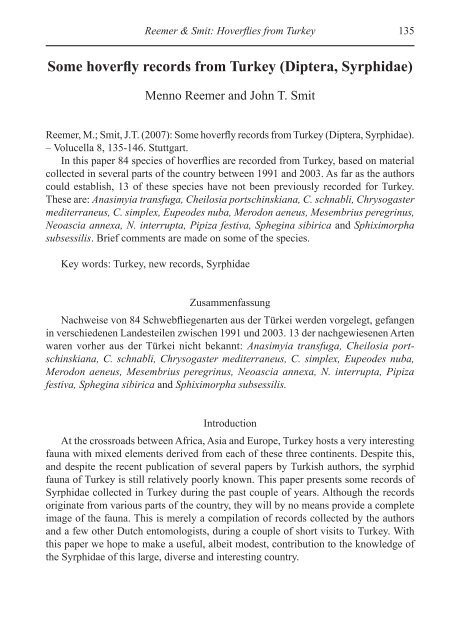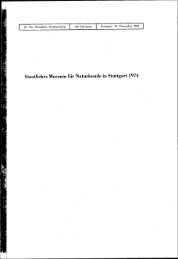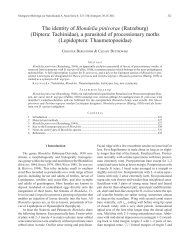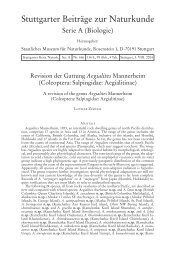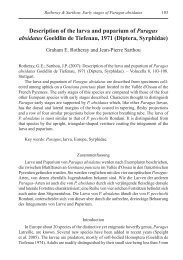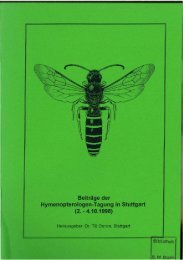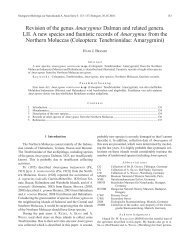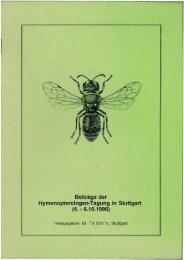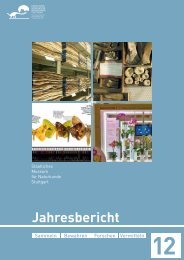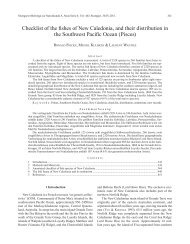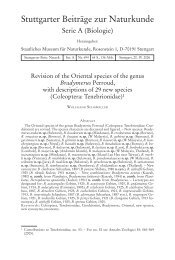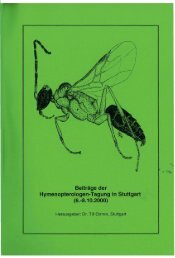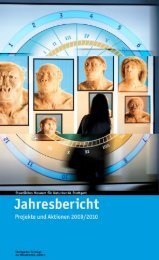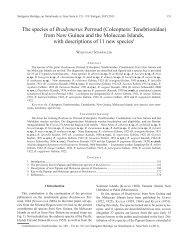Some hoverfly records from Turkey (Diptera, Syrphidae)
Some hoverfly records from Turkey (Diptera, Syrphidae)
Some hoverfly records from Turkey (Diptera, Syrphidae)
- No tags were found...
Create successful ePaper yourself
Turn your PDF publications into a flip-book with our unique Google optimized e-Paper software.
Reemer & Smit: Hoverflies <strong>from</strong> <strong>Turkey</strong>135<strong>Some</strong> <strong>hoverfly</strong> <strong>records</strong> <strong>from</strong> <strong>Turkey</strong> (<strong>Diptera</strong>, <strong>Syrphidae</strong>)Menno Reemer and John T. SmitReemer, M.; Smit, J.T. (2007): <strong>Some</strong> <strong>hoverfly</strong> <strong>records</strong> <strong>from</strong> <strong>Turkey</strong> (<strong>Diptera</strong>, <strong>Syrphidae</strong>).– Volucella 8, 135-146. Stuttgart.In this paper 84 species of hoverflies are recorded <strong>from</strong> <strong>Turkey</strong>, based on materialcollected in several parts of the country between 1991 and 2003. As far as the authorscould establish, 13 of these species have not been previously recorded for <strong>Turkey</strong>.These are: Anasimyia transfuga, Cheilosia portschinskiana, C. schnabli, Chrysogastermediterraneus, C. simplex, Eupeodes nuba, Merodon aeneus, Mesembrius peregrinus,Neoascia annexa, N. interrupta, Pipiza festiva, Sphegina sibirica and Sphiximorphasubsessilis. Brief comments are made on some of the species.Key words: <strong>Turkey</strong>, new <strong>records</strong>, <strong>Syrphidae</strong>ZusammenfassungNachweise von 84 Schwebfliegenarten aus der Türkei werden vorgelegt, gefangenin verschiedenen Landesteilen zwischen 1991 und 2003. 13 der nachgewiesenen Artenwaren vorher aus der Türkei nicht bekannt: Anasimyia transfuga, Cheilosia portschinskiana,C. schnabli, Chrysogaster mediterraneus, C. simplex, Eupeodes nuba,Merodon aeneus, Mesembrius peregrinus, Neoascia annexa, N. interrupta, Pipizafestiva, Sphegina sibirica and Sphiximorpha subsessilis.IntroductionAt the crossroads between Africa, Asia and Europe, <strong>Turkey</strong> hosts a very interestingfauna with mixed elements derived <strong>from</strong> each of these three continents. Despite this,and despite the recent publication of several papers by Turkish authors, the syrphidfauna of <strong>Turkey</strong> is still relatively poorly known. This paper presents some <strong>records</strong> of<strong>Syrphidae</strong> collected in <strong>Turkey</strong> during the past couple of years. Although the <strong>records</strong>originate <strong>from</strong> various parts of the country, they will by no means provide a completeimage of the fauna. This is merely a compilation of <strong>records</strong> collected by the authorsand a few other Dutch entomologists, during a couple of short visits to <strong>Turkey</strong>. Withthis paper we hope to make a useful, albeit modest, contribution to the knowledge ofthe <strong>Syrphidae</strong> of this large, diverse and interesting country.
136Volucella 8, 2007Material and methodsMost of the species recorded were collected in 2000 by the authors in the provinceof Muğla in southwestern <strong>Turkey</strong>. Additional specimens were been collected in otherparts of <strong>Turkey</strong> by Kees Goudsmits, Vincent Kalkman, Herman Teunissen and TheoZeegers in the years 1991, 2001, 2002 and 2003.Most identifications were carried out by the authors, except for the Merodon specimens,which were identified by Willem Hurkmans (Zwolle, Netherlands), and specimensof Eupeodes, which were identified by Libor Mazánek (Olomouc, Czech Republic). Allcollected specimens are deposited in the collections of the authors, except for a smallnumber of specimens in the collection of Kees Goudsmits (Doorn, the Netherlands).To check whether a species had already been recorded for <strong>Turkey</strong>, the followingliterature has been examined: Aktas & Saribiyik (1996, 2001), Candemir & Kara (2003),Claussen & Hayat (1997a, b), Coe (1966), Dirickx (1994), Hayat (1997), Hayat &Alaoğlu (1990a, b), Hayat & Claussen (1997), Hurkmans (1987, 1988, 1993), Hurkmans& Hayat (1997), Lindner (1941), Özgür (1986, 1987), Özgür & Saribiyik (2002), Reemeret al. (2005), Saribyik (1999a, b, 2000a, b, 2001, 2003a, b, c, d, e, 2004), Saribiyik &Aktas (1996), Saribiyik & Hasbenli (1997), Saribyik & Özgür (2000), Speight & Castella(2003), van Steenis (2000), Toth (1986), Van de Weyer (2000).LocalitiesThe localities visited are shown in fig. 1, grouped by province. The first two lettersof the name of the province are used for the locality codes. For each locality, coordinates(latitude/longitude or UTM grid reference), height above sea level (in metres) and thedate(s) of the visit(s) are given. If available, a description of the habitat is given.Afyon: AF01 24 km SW of Çay, Karamk Gölü and irrigation channels 1 km E of Bulanik köy. 38º30’N30º55’E. 1000 m asl. 4.vii.2001 (leg. V.J. Kalkman). AF02 Emir Daglari, 15 km SSE of Emirdag lake at 10km S of Dereköy. 39º00’N 31º10’E. 1500-1700 m asl. 5.vii.2001 (leg. V.J. Kalkman).Antalya: AN01 11 km NW of Kalkan, Eşen Cayı near Kinikli. UTM: 35SQA02. 10 m asl. 27.v.2000 (leg.M. Reemer, J.T. Smit & K. Goudsmits). AN02 4 km W of Kalkan, ancient harbour of Patara S of Gelemiş.UTM: 35SQA01. 5 m asl. 27.v.2000 (leg. M. Reemer, J.T. Smit & K. Goudsmits). AN03 Lake at Civizli, 20km N of Akseki. 37º11’N 31º45’E. 11.vii.2001 (leg. V.J. Kalkman).Artvin: AR01 Coruh N, in the village of Yusufeli. UTM: 37TGF12. 3.vii.2003 (leg. V.J. Kalkman).Gaziantep: GA01 Durnalik, 20 km W of Gaziantep. 13.v.2002 (leg. K. Goudsmits).Içel: IC01 Western side of Akgöl near Denizkent, 8 km S of Silifke, Göksu Delta. 36º17’N 33º56’E.9.vii.2001 (leg. V.J. Kalkman). Dunes. IC02 Abanoz, Anamur, Kazanci 1190 m asl. 36º30’N 32º53’E.10.v.1991 (leg. H. Teunissen).Isparta: IS01 Kovada Milli Park. 37º40’N 30º50’E. 1.vii.2001 (leg. V.J. Kalkman). Freshwater lake.Kayseri: KA01 Yahyali, Ovaçiftliği, Sultanswamp. 1075 m asl. 38º15’N 35º17’E. 7.v.2002 (leg. T.Zeegers).Muğla: MU01 Köyceğiz, just E of village, near Köyceğiz Golü. UTM: 35SPA59. 5 m asl. 21.v.2000,22.v.2000, 24.v.2000, 29.v.2000, 30.v.2000, 3.vi.2000 (leg. M. Reemer, J.T. Smit & K. Goudsmits). Varioushabitats: forest of Liquidamber orientalis with small streams, marshy grasslands and fields with large, flower-
138Volucella 8, 2007m asl. UTM 35SPA69. 1.vi.2000 (leg. J.T. Smit). MU21 5 km S of Köyceğiz, mouth of Yavurlakçayı intoKöyceğiz lake, 5 m asl. UTM 35SPA58. 2.vi.2000 (leg. J.T. Smit).Nevşehir: NE01 Ürgüp, Göreme, 1150 m asl. 38º38’N 34º56’E. 11.v.2002 (leg. T. Zeegers). NE02 Ürgüp,hilltop 3 km W of Ortahisar, 1450 m asl. 38º38’N 34º56’E. 12.v.2002 (leg. T. Zeegers). NE03 Ürgüp, hilltopat Ortahisar, 1300 m asl. 38º38’N 34º56’E. 12.v.2002 (leg. T. Zeegers).Niğde: NI01 Ihlara-Valley, 1250 m. asl. 37º59’N 34º42’E. 15.v.2002 (leg. T. Zeegers). NI02 Sultanhanı,1050 m asl. 38º15’N 33º33’E.17-19.v.2002 (let. T. Zeegers).Trabzon: TR01 2 km E of Yomra, along the Harmanli Çay. . UTM: 37TEF73. 24.vi.2003 (leg. V.J.Kalkman). TR02 10 km S of Arakli, along the Kara Dere. UTM: 37TEF82. 24.vi.2003 (leg. V.J. Kalkman).TR03 Uzungöl. 40º37’N 26º50’E.9.vii.2003 (leg. V.J. Kalkman).Van: VA01 8 km N of Muradiye, Bendimahi Selalesi. UTM: 38SLJ92. 30.vi.2003 (leg. V.J. Kalkman).ResultsIn this paper, 84 species are recorded for <strong>Turkey</strong> (table 1). For each species, theavailable literature has been checked for previous <strong>records</strong> <strong>from</strong> <strong>Turkey</strong>. So far as we canascertain, the following 13 species have not been recorded for <strong>Turkey</strong> before: Anasimyiatransfuga, Cheilosia portschinskiana, C. schnabli, Chrysogaster mediterraneus, C.simplex, Eupeodes nuba, Merodon aeneus, Mesembrius peregrinus, Neoascia annexa,N. interrupta, Pipiza festiva, Sphegina sibirica and Sphiximorpha subsessilis.Notes on some speciesCheilosia canicularis: These specimens have been checked for the closely relatedspecies C. griseifacies Vujić, 1994, C. himantopus (Panzer, 1798) and C. orthotrichaVujić & Claussen, 1994 using characters provided by Stuke & Claussen (2000), Vujić(1994) and Vujić & Claussen (1994).Cheilosia portschinskiana: It is possible that some of the <strong>records</strong> of C. illustrata inSaribiyik (2001) belong to this species as well.Cheilosia schnabli: This species is very similar to C. impressa Loew, 1840, buteasily recognized by the characters described by Vujić et al. (1998), especially in directcomparison. C. schnabli has so far been recorded <strong>from</strong> the Balkan and the Caucasus. Thisnew record of a male specimen is <strong>from</strong> a mountain range extending <strong>from</strong> the Caucasusalong the southeastern Black Sea.Chrysogaster mediterraneus: This appears to be the first record outside the Balkans,<strong>from</strong> where it has been described by Vujić (1999). It is possible that the specimens ofthe very similar C. solstitialis (Fallén, 1817) reported by Saribiyik (1999b, 2001) alsobelong to this species.Merodon velox: At the end of a hot day, a male specimen was observed drinking ata small stream along a roadside.Neoascia annexa: The specimens have been compared with the description of N.subannexa by Claussen & Hayat (1997a), but they did not belong to that species. Theyhave also been compared with specimens of N. annexa <strong>from</strong> Northwest-Europeancountries, to which they were found to be very similar.
Reemer & Smit: Hoverflies <strong>from</strong> <strong>Turkey</strong>139Platycheirus scutatus: This specimen has been checked for the closely related P.aurolateralis Stubbs, 2002, P. speighti Doczkal et al., 2002 and P. splendidus Rotheray,1998.Riponnensia insignis: A large series of this little known species has been collectednear Köyceğiz (prov. Muğla). The specimens were taken <strong>from</strong> Euphorbia flowers ona marshy grassland next to a forest of Liquidamber orientalis with small streams. R.insignis has previously been recorded for <strong>Turkey</strong> by Dirickx (1994) (without citing theoriginal reference for this record) and by Özgür (1987). Males can be identified mostreliably using the drawings of the genitalia provided by Maibach et al. (1994) in combinationwith Claussen (1991) and Vujiċ (1999). The female has not been described yet, butwould run to the correct species in the keys of Sack (1932) and Stackelberg (1953).Sphegina sibirica: Has been recorded <strong>from</strong> the adjacent Caucasus by Toth (1986).Sphiximorpha subsessilis: The specimens were checked for other Sphiximorphaspecies, including S. worelli (Bradescu, 1972), which has recently been recordedfor <strong>Turkey</strong> by Saribiyik (2003a). We have also compared them with specimens of S.subsessilis <strong>from</strong> other European countries and found that they are very similar in bothexternal morphology and male genitalia.DiscussionAn annotated checklist would be a very useful instrument in the study of the <strong>Syrphidae</strong>of <strong>Turkey</strong>. The compilation of a reliable checklist would require a great effort,because of the taxonomic challenge lurking in the fauna of this country, probably stillcontaining many undescribed species. Besides, it would be necessary to re-examinethe <strong>records</strong> of several species which have been published in older literature, in order toestablish their true identity. This is required in the case of species complexes containingrecently described 'cryptic species', for instance: Chrysogaster mediterraneus / C. solstitialis,Myolepta dubia / M. trojana, Paragus bicolor / P. romanicus and Platycheirusaurolateralis / P. scutatus / P. splendidus.Large collections of Turkish <strong>Syrphidae</strong>, containing a lot of unidentified materialand undescribed species, are awaiting examination. An important example is the collectionof J.A.W. Lucas, now included in the collection of the ZMAN in Amsterdam(the Netherlands). Such important collections should not be ignored when examiningthe Turkish fauna.AcknowledgementsWe are indebted to Kees Goudsmits, Vincent Kalkman, Herman Teunissen and Theo Zeegers for enablingus to include <strong>records</strong> <strong>from</strong> their collecting trips in <strong>Turkey</strong>. Willem Hurkmans and Libor Mazánek have beenhelpful in identifying some Merodon and Eupeodes specimens, for which we are very grateful. We wouldalso like to thank Suleyman Saribiyik for kindly sending us reprints of several useful papers on the Turkish<strong>Syrphidae</strong> fauna.
140Volucella 8, 2007ReferencesAktas, M.; Saribiyik, S. (1996): Contribution to the <strong>Syrphidae</strong> fauna of <strong>Turkey</strong> (<strong>Diptera</strong>: <strong>Syrphidae</strong>) II.Milesiinae. – Journal of the Institute of Science and Technology, Gazi University 9, 15-27.Aktas, M.; Saribiyik, S. (2001): New <strong>records</strong> of Syrphinae (<strong>Diptera</strong>: <strong>Syrphidae</strong>) <strong>from</strong> <strong>Turkey</strong>. – Journal ofthe Entomological Research Society 31, 41-46.Candemir, D.; Kara, K. (2003): <strong>Syrphidae</strong> (<strong>Diptera</strong>) fauna in Tokat provinces (<strong>Turkey</strong>). – Türkiye EntomolojiDergisi 27, 95-105.Claussen, C. (1991): Eine neue Orthonevra von Korsika (<strong>Diptera</strong>, <strong>Syrphidae</strong>). – Entomofauna 12(16), 205-211.Claussen, C.; Hayat, R. (1997a): A new species of the genus Neoascia Williston, 1886 (<strong>Diptera</strong>, <strong>Syrphidae</strong>)<strong>from</strong> North-East <strong>Turkey</strong>. – Studia Dipterologica 4, 215-218.Claussen, C.; Hayat, R. (1997b): Anew species and new <strong>records</strong> of the genus Pipizella Rondani, 1856 (<strong>Diptera</strong>,<strong>Syrphidae</strong>) <strong>from</strong> <strong>Turkey</strong>. – Studia Dipterologica 4, 447-452.Coe, R.L. (1966): A new Sericomyia <strong>from</strong> <strong>Turkey</strong> (<strong>Diptera</strong>: <strong>Syrphidae</strong>). – Entomologisk Tidskrift 87, 118-120.Dirickx, H.G. (1994): Atlas des Diptères syrphides de la région méditerranéenne. – Studiedocumenten vanhet Koninklijk Belgisch Instituut voor Natuurwetenschappen 75, 1-317.Hayat, R.; Alaoğlu, Ö. (1990a): Erzurum yöresi <strong>Syrphidae</strong> (<strong>Diptera</strong>) faunasi (I). Syrphinae. – Türkiye EntomolojiDergisi 14, 173-182.Hayat, R.; Alaoğlu, Ö. (1990b): Erzurum yöresi <strong>Syrphidae</strong> (<strong>Diptera</strong>) faunasi (II). Milesiinae. – TürkiyeEntomoloji Dergisi 14, 227-234.Hayat, R.; Claussen, C. (1997): A new species and new <strong>records</strong> of the genus Paragus Latreille, 1804 <strong>from</strong><strong>Turkey</strong> (<strong>Diptera</strong>: <strong>Syrphidae</strong>). – Zoology in the Middle East 14, 99-108.Hurkmans, W. (1987): Merodon telmateia, a new <strong>hoverfly</strong> <strong>from</strong> <strong>Turkey</strong> (<strong>Diptera</strong>: <strong>Syrphidae</strong>). – EntomologischeBerichten 47, 119-121.Hurkmans, W. (1988): Ethology and ecology of Merodon in <strong>Turkey</strong> (<strong>Diptera</strong>: <strong>Syrphidae</strong>). – EntomologischeBerichten 48, 107-114.Hurkmans, W. (1993): A monograph of Merodon (<strong>Diptera</strong>: <strong>Syrphidae</strong>). Part 1. – Tijdschrift voor Entomologie136, 147-234.Hurkmans, W.; Hayat, R. (1997): Ethology and ecology of Merodon (<strong>Diptera</strong>, <strong>Syrphidae</strong>) in <strong>Turkey</strong> II: descriptionsof new species and notes on other syrphid flies. – Dipterists Digest 3, 62-79.Lindner, E. (1941): Eine entomologische Studienfahrt nach Anatolien und ihre dipterologischen Ergebnisse.– Jahreshefte des Vereins für Vaterländische Naturkunde in Württemberg 96, 113-136.Maibach, A.; Goeldlin de Tiefenau, P.; Speight, M.C.D. (1994): Limites génériques et caractéristiques taxonomiquesde plusieurs genres de la tribu des Chrysogasterini (<strong>Diptera</strong>: <strong>Syrphidae</strong>). I. Diagnoses génériques etdescription de Riponnensia gen. nov. – Annales de la Société Entomologique de France 30, 217-247.Milankov, V.; Vujić, A.; Ludoski, J. (2001): Genetic divergence among cryptic taxa of Merodon avidus (Rossi,1790) (<strong>Diptera</strong>: <strong>Syrphidae</strong>). – International Journal of Dipterological Research 12, 15-24.Özgür, A.F. (1986): Akdeniz Bölgesi avci <strong>Syrphidae</strong> Türleri. – Proceedings of the first Turkish national congressof biological control, Çukurova Üniversitesi Ziraat Fakültesi Bitki Koruma Bölümü, Adana, 293-303.Özgür, A.F. (1987): Die Fauna der Familie <strong>Syrphidae</strong> (Dipt.) von Mittelmeerküstengebiet der Türkei. II. Unterfamilien:Cheilosiinae, Sphegininae, Pelecocerinae, Milesiinae, Chrysotoxinae, Volucellinae. – ZiraatFakültesi Dergisi, Çukurova Üniversitesi, Adana 2, 67-81.Özgür, A.F.; Saribiyik, S. (2002): New <strong>records</strong> of Microdontinae (<strong>Diptera</strong>: <strong>Syrphidae</strong>) <strong>from</strong> <strong>Turkey</strong>. – Journalof the Entomological Research Society 4, 15-17.Reemer, M.; Hauser, M; Speight, M.C.D. (2005): The genus Myolepta Newman in the West-Palaearcticregion. – Studia dipterologica 11(2), 553-580.Sack, P. (1932): <strong>Syrphidae</strong>. – Die Fliegen der palaearktischen Region 4, 1-451.Saribyik, S. (1999a): Syrphinae fauna of the West Blacksea Region (<strong>Diptera</strong>: <strong>Syrphidae</strong>). – KastamonuEğitim Dergisi 7, 185-194.Saribiyik, S. (1999b): Milesiinae fauna of the West Blacksea Region (<strong>Diptera</strong>: <strong>Syrphidae</strong>). – KastamonuEğitim Dergisi 7, 195-204.
Reemer & Smit: Hoverflies <strong>from</strong> <strong>Turkey</strong>141Saribiyik, S. (2000a): Fauna of <strong>Syrphidae</strong> in Ilgaz and Isik mountains and their vicinity (<strong>Diptera</strong>-Syrphinae).– Journal of the Institute of Science and Technology, Gazi University 13, 55-70.Saribiyik, S. (2000b): Two new <strong>records</strong> for the Turkish Milesiinae fauna (<strong>Diptera</strong>: <strong>Syrphidae</strong>). – Bitki KorumaBülteni 40, 179-181.Saribiyik, S. (2001): New <strong>records</strong> of the subfamily Milesiinae (<strong>Diptera</strong>: <strong>Syrphidae</strong>) <strong>from</strong> <strong>Turkey</strong>. – Journalof the Entomological Research Society 3, 43-51.Saribiyik, S. (2003a): Sphiximorpha worelli (Bradescu, 1972), (<strong>Diptera</strong>: <strong>Syrphidae</strong>) New record for the faunaof <strong>Turkey</strong>. – Journal of the Entomological Research Society 5, 13-16.Saribiyik, S. (2003b): Fauna of Syrphinae and Milesiinae (<strong>Diptera</strong>: <strong>Syrphidae</strong>) around Tuz Lake. – KastamonuEducation Journal 11, 439-450.Saribiyik, S. (2003c): The evaluation of the works on <strong>Syrphidae</strong> (<strong>Diptera</strong>) fauna in the western Blacksearegion. – Kastamonu Education Journal 11, 461-466.Saribiyik, S. (2003d): Milesiinae fauna of Kahramanmaras's Andirin town (<strong>Diptera</strong>: <strong>Syrphidae</strong>). – KastamonuEducation Journal 11, 159-164.Saribiyik, S. (2003e): Syrphinae fauna of Kahramanmaras's Andirin town (<strong>Diptera</strong>: <strong>Syrphidae</strong>). – KastamonuEducation Journal 11, 193-198.Saribiyik, S. (2004): Three new <strong>records</strong> for Turkish Milesiinae fauna (<strong>Diptera</strong>: <strong>Syrphidae</strong>). – Journal of theEntomological Research Society 6, 19-22.Saribiyik, S.; Aktas, M. (1996): Contributions to the <strong>Syrphidae</strong> fauna of <strong>Turkey</strong> (<strong>Diptera</strong>: <strong>Syrphidae</strong>) I. Syrphinae.– Journal of the Institute of Science and Technology, Gazi University 9, 1-13.Saribiyik, S.; Hasbenli, A. (1997): Türkiye <strong>Syrphidae</strong> (<strong>Diptera</strong>) faunasi icin yeni kayitlar. – Türkiye EntomolojiDergisi 21, 225-232.Saribyik, S.; Özgür, A.F. (2000): New <strong>records</strong> of Milesiinae (<strong>Diptera</strong>: <strong>Syrphidae</strong>) <strong>from</strong> <strong>Turkey</strong>. – Journal ofthe Entomological Research Society 2, 5-13.Speight, M.C.D.; Castella, E. (2003): Range and status data for European <strong>Syrphidae</strong> (<strong>Diptera</strong>), 2003. – In:Speight, M.C.D.; Castella, E.; Sarthou, J.P.; Ball, S. (eds.), Syrph the Net, the database of European<strong>Syrphidae</strong> 42, 1-370. Dublin (Syrph the Net publications).Stackelberg, A.A. (1953): Palearkticheskie vidy roda Orthoneura Macq. (<strong>Diptera</strong>, <strong>Syrphidae</strong>). – EntomologiceskoeObozrenie 33, 342-357.Steenis, J. van (2000): The West-Palaearctic species of Spilomyia Meigen (<strong>Diptera</strong>, <strong>Syrphidae</strong>). – Mitteilungender Schweizerischen Entomologischen Gesellschaft 73, 143-168.Stuke, J.-H.; Claussen, C. (2000): Cheilosia canicularis auctt. - ein Artenkomplex. – Volucella 5, 79-94.Toth, S. (1986): Beiträge zur Kenntnis der Schwebfliegen-Fauna des Südwest-Kaukasus (<strong>Diptera</strong>: <strong>Syrphidae</strong>).– Folia Musei Historico-Naturalis Bakonyiensis 5, 85-98.Van de Weyer, G. (2000): A new syrphid fly species of the Paragus serratus complex <strong>from</strong> <strong>Turkey</strong> (<strong>Diptera</strong>:<strong>Syrphidae</strong>). – Phegea 28, 149-152.Vujić, A. (1994): Cheilosia griseifacies, eine neue Fliegen-Art aus Mitteleuropa (<strong>Diptera</strong>, <strong>Syrphidae</strong>). – Entomofauna15, 337-344.Vujić, A. (1999): The tribe Chrysogasterini (<strong>Diptera</strong>: <strong>Syrphidae</strong>) in the Balkan Peninsula, with the descriptionof three new cryptic species. – Studia Dipterologica 6, 405-423.Vujić, A.; Claussen, C. (1994): Cheilosia orthotricha spec. nov., eine weitere Art aus der Verwandtschaft vonCheilosia canicularis aus Mitteleuropa. – Spixiana 17, 261-267.Vujić, A.; Radenković, S.; Stănescu, C. (1998): New data on hoverflies (<strong>Diptera</strong>, <strong>Syrphidae</strong>) in Romania.– Volucella 3, 63-74.Addresses of authors:Menno Reemer & John T. Smit, EIS-Nederland, Postbus 9517, 2300 RA Leiden, TheNetherlands. E-mail: reemer@naturalis.nl, smitj@naturalis.nl
142Volucella 8, 2007Table 1: Hoverfly <strong>records</strong> <strong>from</strong> <strong>Turkey</strong>. The locality codes are explained in the text. In some cases the numberand sex of the specimens is given between brackets (f = female, m = male). In the last column references aregiven to literature in which the species has previously been recorded for <strong>Turkey</strong>.species localities previous references for <strong>Turkey</strong>1. Anasimyia transfuga(Linnaeus, 1758)2. Brachypalpoides lentus(Meigen, 1822)3. Ceriana conopsoides(Linnaeus, 1758)4. Ceriana vespiformis(Latreille, 1809)5. Chalcosyrphus nemorum(Fabricius, 1805)6. Cheilosia aereaDufour, 18487. Cheilosia canicularis(Panzer, 1801)8. Cheilosia portschinskianaStackelberg, 19609. Cheilosia schnabliBecker, 189410. Cheilosia soror(Zetterstedt, 1843)11. Chrysogaster mediterraneusVujić, 199912. Chrysogaster simplexLoew, 184313. Chrysotoxum cautum(Harris, 1776)14. Chrysotoxum festivum(Linnaeus, 1758)15. Chrysotoxum intermediumMeigen, 1822IS01 (1 f)MU18 (1 m) Dirickx (1994)MU01, MU02 Dirickx (1994), Saribiyik (2001, 2003b,c)MU01, MU02, Dirickx (1994)MU03, MU05,MU14, MU18,MU19MU01 Saribyik & Özgür (2000)NI01 (1 m),MU10 (2 f)Dirickx (1994; as C. zetterstedti)Lindner (1941; as C. zetterstedti)AR01, TR03 Saribiyik (1999b, 2001)TR03 (1 f)TR03 (1 m)MU10MU01 (2 m),MU18 (1 m)MU18 (2 m,2 f)IC02 (1 m),MU10 (1 f),UR01 (1 m)VA01 (1 m)Aktas & Saribiyik (1996; as C. rufipes),Özgür (1987), Saribiyik (1999b, 2001,2003d; as C. rufipes), Saribiyik (2003b,c)Candemir & Kara (2003), Dirickx (1994),Saribiyik (1999a, 2003b, c)Dirickx (1994), Hayat & Alaoğlu (1990a),Hurkmans & Hayat (1997), Saribiyik(1999a, 2000a, 2003b, c), Saribiyik &Aktas (1996)MU10 (1 f) Candemir & Kara (2003), Dirickx (1994),Özgür (1987), Saribiyik (1999a, 2000a,2003b, c, e), Saribiyik & Aktas (1996)16. Epistrophe eligans(Harris, 1780)IC02 (2 m)Dirickx (1994), Saribiyik (1999a, 2000c),Özgür (1986), Saribiyik & Aktas (1996)
Reemer & Smit: Hoverflies <strong>from</strong> <strong>Turkey</strong>14317. Episyrphus balteatus(De Geer, 1776)MU01, MU02,MU18Candemir & Kara (2003), Dirickx (1994),Özgür (1986), Saribiyik (1999a, 2000a,2003b, c, e), Saribiyik & Aktas (1996)18. Eristalinus aeneus(Scopoli, 1763)19. Eristalinus megacephalus(Rossi, 1794)20. Eristalinus sepulchralis(Linnaeus, 1758)21. Eristalinus taeniops(Wiedemann, 1818)22. Eristalis arbustorum(Linnaeus, 1758)23. Eristalis similis(Fallén, 1817)MU01, MU03,MU05MU01, MU02,MU03AF01, MU01,MU02, MU03,MU04, MU21MU01, MU03,MU05, MU06,MU11, MU14AF01, MU01,MU02, MU03,MU05, MU10,MU15, MU18MU10Aktas & Saribiyik (1996), Candemir &Kara (2003), Dirickx (1994), Saribiyik(1999b, 2001, 2003b, c, d)Aktas & Saribiyik (1996; as E.quinquelineatus), Dirickx (1994)Aktas & Saribiyik (1996), Dirickx (1994),Saribiyik (1999b, 2001, 2003b, c, d)Aktas & Saribiyik (1996), Dirickx (1994),Saribiyik (2003d)Aktas & Saribiyik (1996), Candemir &Kara (2003), Dirickx (1994), Hayat &Alaoğlu (1990b), Hurkmans & Hayat(1997), Lindner (1941), Saribiyik (1999b,2001, 2003b, c, d)Dirickx (1994; as E. pratorum), Saribiyik(1999b, 2001, 2003c, d; as E. pratorum)24. Eristalis tenax(Linnaeus, 1758)25. Eupeodes corollae(Fabricius, 1794)AF01, AF02,AN03, MU01,MU03, MU05,MU09, MU10,MU15, MU16,MU18, MU19,TR03, MU20MU02, MU10,MU15, NE01Aktas & Saribiyik (1996), Candemir &Kara (2003), Dirickx (1994), Hayat &Alaoğlu (1990b), Hurkmans & Hayat(1997), Lindner (1941), Saribiyik (1999b,2001, 2003b, c, d)Candemir & Kara (2003), Dirickx (1994),Hayat & Alaoğlu (1990a), Lindner (1941),Özgür (1986), Saribiyik (1999a, 2000a,2003b, c, e), Saribiyik & Aktas (1996)26. Eupeodes flaviceps(Rondani, 1857)27. Eupeodes latifasciatus(Macquart, 1829)28. Eupeodes luniger(Meigen, 1822)29. Eupeodes nuba(Wiedemann, 1830)30. Helophilus trivittatus(Fabricius, 1805)31. Lejogaster tarsata(Meigen, 1822)NE02 (3 m) Dirickx (1994)MU01, MU10,MU15MU15 (1 m)MU21 (1 m)Dirickx (1994), Özgür (1986), Saribiyik(1999a, 2000a, 2003c, e)Dirickx (1994), Özgür (1986), Saribiyik(1999a, 2000a, 2003c)MU01, MU03 Aktas & Saribiyik (1996; as H.parallelus), Dirickx (1994), Saribiyik(1999b, 2001, 2003c, d; as H.parallelus)AF01, NI02,MU07Aktas & Saribiyik (1996), Dirickx (1994),Özgür (1987), Saribiyik (1999b, 2001,2003b, c, d; as L. splendida)
144Volucella 8, 200732. Melanogaster nuda(Macquart, 1829)MU10, MU16Dirickx (1994; as Chrysogaster viduata),Özgür (1987; as Chrysogaster viduata)33. Melanostoma mellinum(Linnaeus, 1758)34. Melanostoma scalare(Fabricius, 1794)35. Merodon aeneusMeigen, 182236. Merodon albifronsMeigen, 182237. Merodon alexejiParamonov, 192538. Merodon avidusRossi, 1790; form A sensuMilankov et al. 200139. Merodon cf. geniculatusStrobl, 190940. Merodon loewiVan der Goot, 196441. Merodon longicornisSack, 191342. Merodon minutusStrobl, 189343. Merodon spinitarsisParamonov, 192944. Merodon telmateiaHurkmans, 198745. Merodon veloxLoew, 186946. Mesembrius peregrinus(Loew, 1846)47. Microdon devius(Linnaeus, 1758)48. Milesia crabroniformis(Fabricius, 1775)49. Milesia semiluctifera(Villers, 1789)50. Myathropa florea(Linnaeus, 1758)51. Neoascia annexa(Meigen, 1822)MU01, MU02,MU03, MU05,MU06, MU09,MU10, MU11,MU16, MU17,MU18, MU20,MU21Candemir & Kara (2003), Dirickx (1994),Hayat & Alaoğlu (1990a), Özgür (1986),Saribiyik (1999a, 2000a, 2003b, c, e),Saribiyik & Aktas (1996)MU11 Dirickx (1994), Saribiyik (1999a, 2000a,e)MU10 (1 f)MU10 (1 m) Dirickx (1994)MU16 Hurkmans & Hayat (1997)MU15 (5 m),MU16 (3 m),MU17 (1 m, 1 f)MU03 (1 m) Dirickx (1994)Dirickx (1994), Hurkmans (1988, 1993),Hurkmans & Hayat (1997)NE03 (1 m) Hurkmans (1988), Saribiyik (2003b, c, d)MU04 (1 m) Hurkmans (1993), Saribiyik (2003b, d)MU03 (1 m), Dirickx (1994)MU16 (1 f)MU03 (1 m) Dirickx (1994)MU03 (9m,6 f)MU03 (1 f),MU05 (1 m)Dirickx (1994), Hurkmans (1987)Dirickx (1994), Hurkmans (1993),Hurkmans & Hayat (1997), Saribiyik(1999b, 2001, 2003b, c, d)AF01, MU01,MU02TR01 (1) Dirickx (1994), Özgür & Saribiyik (2002)MU01 (1)Dirickx (1994), Saribiyik (2003d)MU01 (11) Aktas & Saribiyik (1996), Dirickx (1994),Saribiyik (1999b, 2003c, d)MU01, MU02,MU05, MU10MU15 (9 m,3 f)Aktas & Saribiyik (1996), Candemir &Kara (2003), Dirickx (1994), Saribiyik(1999b, 2001, 2003c, d)
Reemer & Smit: Hoverflies <strong>from</strong> <strong>Turkey</strong>14552. Neoascia interrupta(Meigen, 1822)53. Neoascia podagrica(Fabricius, 1775)54. Orthonevra frontalis(Loew, 1843)55. Orthonevra nobilis(Fallén, 1817)56. Paragus abrogansGoeldlin de Tiefenau, 197157. Paragus bicolor(Fabricius, 1794)58. Paragus compeditusWiedemann, 183059. Paragus haemorrhousMeigen, 182260. Paragus pecchioliiRondani, 185761. Paragus quadrifasciatusMeigen, 182262. Paragus romanicusStănescu, 199263. Paragus tibialis(Fallén, 1817)64. Parhelophilus versicolor(Fabricius, 1794)65. Pipiza festivaMeigen, 182266. Platycheirus fulviventris(Macquart, 1828)67. Platycheirus scutatus(Meigen, 1822)68. Riponnensia insignis(Loew, 1843)69. Riponnensia longicornis(Loew, 1843)KA01 (3 f)MU01, MU10,MU16, MU17NI02 (1 m),MU17 (8 m, 6 f)Candemir & Kara (2003), Dirickx (1994),Lindner (1941), Özgür (1987), Saribiyik(1999b, 2001, 2003b, c, d)Aktas & Saribiyik (1996), Dirickx (1994),Özgür (1987), Saribiyik (2003b)MU10 (1 m) Dirickx (1994), Saribiyik (2001, 2003b,c)MU18 (1m) Hayat & Alaoğlu (1990a)MU18 (1 m) Candemir & Kara (2003), Dirickx (1994),Hayat & Alaoğlu (1990a), Özgür (1986),Saribiyik (1999a, 2000a, 2003b, c, e),Saribiyik & Aktas (1996)MU01 (1 m)MU01, MU02,MU03, MU07,MU10, MU16,MU18, MU21MU01, MU02,MU18AF01, MU05Dirickx (1994), Hayat & Claussen(1997), Saribiyik (2003b)Hayat & Claussen (1997)Dirickx (1994; as P. majoranae)Candemir & Kara (2003), Saribiyik(2000a, 2003b, c)MU15 (1 m) Hayat & Claussen (1997)MU01, MU09,NI02AF01, MU01,MU02, MU21IC02Candemir & Kara (2003), Dirickx (1994),Hayat & Alaoğlu (1990a), Özgür (1986),Saribiyik (1999a, 2000a, 2003b, c, e),Saribiyik & Aktas (1996)Dirickx (1994)MU01, MU04 Dirickx (1994)MU18 (1 m)MU01 (17 m,23 f)MU01 (2 f)Saribyik & Hasbenli (1997), Saribiyik(2000a, c)Dirickx (1994), Özgür (1987; asChrysogaster insignis)Dirickx (1994), Özgür (1987), Saribiyik(2003b; as Orthonevra longicornis)70. Scaeva albomaculata(Macquart, 1842)GA01 (1 m,1 f)Candemir & Kara (2003), Dirickx (1994),Özgür (1986), Hayat & Alaoğlu (1990a),Saribiyik (2000a, 2003b, c, e), Saribiyik& Aktas (1996)
146Volucella 8, 200771. Sphaerophoria rueppelli(Wiedemann, 1830)72. Sphaerophoria scripta(Linnaeus, 1758)73. Sphaerophoria turkmenicaBankowska, 196474. Sphegina sibiricaStackelberg, 195375. Sphiximorpha subsessilis(Illiger, 1807)76. Syritta flaviventrisMacquart, 184277. Syritta pipiens(Linnaeus, 1758)78. Volucella bombylans(Linnaeus, 1758)79. Volucella pellucens(Linnaeus, 1758)80. Volucella zonaria(Poda, 1761)81. Xanthogramma pedissequum(Harris, 1776)82. Xylota ignava(Panzer, 1798)83. Xylota segnis(Linnaeus, 1758)84. Xylota sylvarumLinnaeus, 1758)MU01, MU03,MU06, MU08,MU11, MU16,MU18AR01, IS01,MU01, MU02,MU03, MU04,MU05, MU06,MU09, MU10,Mu11, MU15,MU16, MU17,MU18, MU19,TR03GA01 (1 m)TR03IC02 (1 f),MU01 (3 m,2 f)MU01, MU03,MU05, AN02AF01, KA01,MU01, MU02,MU03, MU04,MU05, MU06,MU08, MU09,MU10, Mu11,MU12, MU15,MU16, MU18,MU19Candemir & Kara (2003), Dirickx (1994),Özgür (1986), Saribiyik (1999a, 2000a,2003b, c, e)Candemir & Kara (2003), Dirickx (1994),Hayat & Alaoğlu (1990a), Lindner(1941), Özgür (1986), Saribiyik (1999a,2000a, 2003b, c, e), Saribiyik & Aktas(1996)Hayat & Alaoğlu (1990a)Dirickx (1994)Aktas & Saribiyik (1996), Candemir &Kara (2003), Dirickx (1994), Hayat &Alaoğlu (1990b), Lindner (1941), Özgür(1987), Saribiyik (1999b, 2001, 2003b,c, d)TR03 (1) Dirickx (1994), Saribiyik (2001, 2003c)TR02 (1) Saribiyik (2001, 2003c)MU01, MU10,MU13MU01, MU10,TR02Aktas & Saribiyik (1996), Hurkmans &Hayat (1997), Özgür (1987), Saribiyik(1999b, 2001, 2003b, c, d)Özgür (1986; as X. ornatum), Saribiyik(1999a, 2000a, 2003b, c, e), Saribiyik &Aktas (1996)AR01 (1 m) Dirickx (1994), Saribyik & Özgür (2000)MU09 (1 m)MU01 (1 m,1 f)Dirickx (1994), Özgür (1987), Saribiyik(1999b, 2001, 2003c, d)Dirickx (1994), Saribiyik (1999b, 2001,2003c, d)


